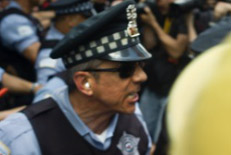Whatever good reasons there were to go to war after 9/11, there’s no argument against war more eloquent than the current quagmire. So with billions of dollars spent and thousands of lives lost, the NATO Summit meeting in Chicago on May 20 and 21 was an opportunity for dissident protest as well as decision-making by the ministers congregated within the McCormick Center.
Stores and businesses closed. Windows were boarded up. Visiting NATO dignitaries were warned not to wear suits or corporate attire while strolling around downtown.
In 1968, during the Democratic National Convention, the Chicago police infamously attacked protesters and campaign workers. Back then, Senator Abe Ribicoff of Connecticut spoke of “Gestapo tactics” from the convention podium and Mayor Richard Daley replied with profanities on the still-novel medium of live television. Both men are long dead, but the culture war that Chicago police tactics brought into sharp focus continues unabated. So even now, the Chicago establishment has worked itself into a defensive frenzy over the prospect of anti-war demonstrators on the streets.
The Occupy movement, after a wildly successful autumn followed by a long, frustrating winter, joined in massive rallies to protest NATO’s continuing war. However, as it turned out, the largest demonstration numbered in the thousands—perhaps ten thousand people—rather than the hordes that were expected. Moreover, the vast majority of marchers were entirely peaceful, led by Veterans Against The Wars who symbolically returned their medals and spoke movingly of feeling, this last decade, that their blood had been sacrificed in vain.
Chicago police, though, considered the presence of a hundred radical “Black Bloc” anarchists enough to trigger a full-scale melee of swinging billy clubs. Several dozen protesters were wounded and scores arrested. Journalists were beaten or arrested as well, despite having press credentials. It was a self-fulfilling theater of violence—for both sides—rather than any true expression of either crowd control or popular agitation. But the injuries are real.
